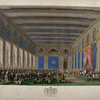Continuity and Discontinuity of the Constitutional Monarchy from a Transnational Perspective: The Netherlands-Belgium (1815-1831)
DOI:
https://doi.org/10.18352/bmgn-lchr.10149Keywords:
Monarchy, Nation, formation, Constitutions, William I, Leopold IAbstract
The constitutional monarchy as an essential ‘modern’ state form of the restoration period was intended to restore order and stability in Europe. In this respect, there is more of a break than continuity between the constitutional model that William I introduced in 1814-1815 and the constitutional monarchy to which Leopold I, the first king of the Belgians, had to subject himself in 1831. The specific authoritarian interpretation that William I gave to his function was one of the factors that helps to explain the Belgian revolution. It is therefore logical that the revolution, as such, produced a constitution that firstly, in general was far more democratic and, secondly, specifically restricted the power of the king. The new Belgian constitutional monarchy of 1830-1831 did not keep William I’s ‘heritage’ intact: onthe contrary, the constitutional definition of kingship in Belgium, for that time, was an ultra-liberal, modern answer to the ‘William I system’.
Continuïteit en discontinuïteit van de constitutionele monarchie vanuit een transnationaal perspectief. Nederland-België (1815-1831)
De constitutionele monarchie moest als een essentieel ‘moderne’ staatsvorm in het restauratietijdperk voor een herstel van orde en stabiliteit zorgen in Europa. Er is op dit punt eerder sprake van een breuk dan van continuïteit tussen het grondwettelijk model dat Willem I in 1814-1815 invoerde in het Verenigd Koninkrijk der Nederlanden en de constitutionele monarchie waaraan Leopold I zich als eerste koning der Belgen in 1831 moest onderwerpen. De specifieke interpretatie en autoritaire invulling die Willem I aan zijn functie gaf, was één van de factoren die de Belgische revolutie mee helpt verklaren. Het is dus logisch dat de revolutie als zodanig een grondwet opleverde die ten eerste in het algemeen veel democratischer was, en ten tweede specifiek de macht van de koning sterk inperkte. De Belgische grondwettelijke monarchie die uit een revolutie werd geboren, hield de ‘erfenis’ van Willem I dus niet intact: de grondwettelijke omschrijving van het koningschap was integendeel een voor die tijd ultraliberaal en modern antwoord op het ‘systeem-Willem I’.
Downloads

Published
Issue
Section
License
Authors who publish with this journal agree to the following terms:
a) Authors retain copyright and grant the journal right of first publication with the work simultaneously licensed under a Creative Commons Attribution 4.0 International (CC BY 4.0) that allows others to share the work with an acknowledgement of the work's authorship and initial publication in this journal.
b) Authors are able to enter into separate, additional contractual arrangements for the non-exclusive distribution of the journal's published version of the work (e.g., post it to an institutional repository or publish it in a book), with an acknowledgement of its initial publication in this journal.
c) Authors are permitted to post their work online (e.g., in institutional repositories or on their website) prior to and during the submission process.
Authors are explicitly encouraged to deposit their published article in their institutional repository.







